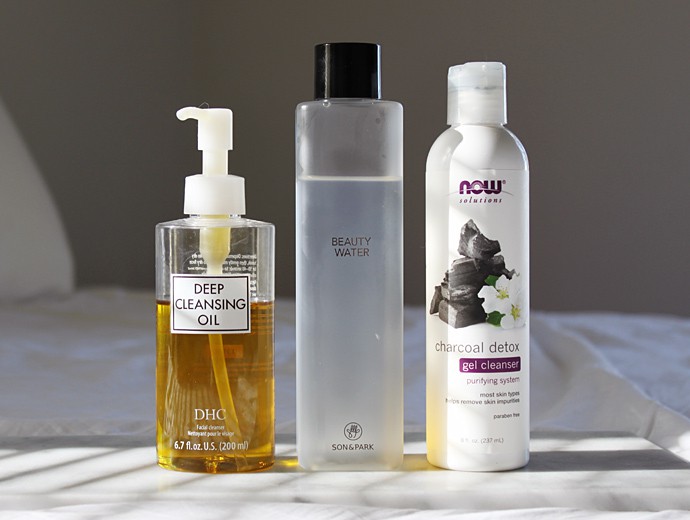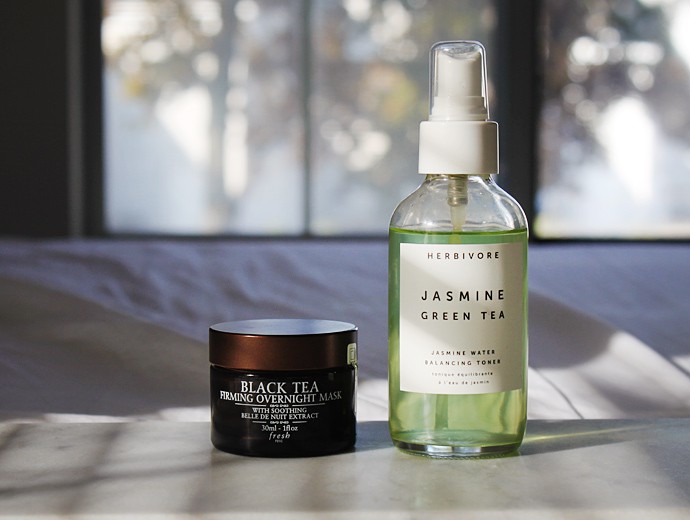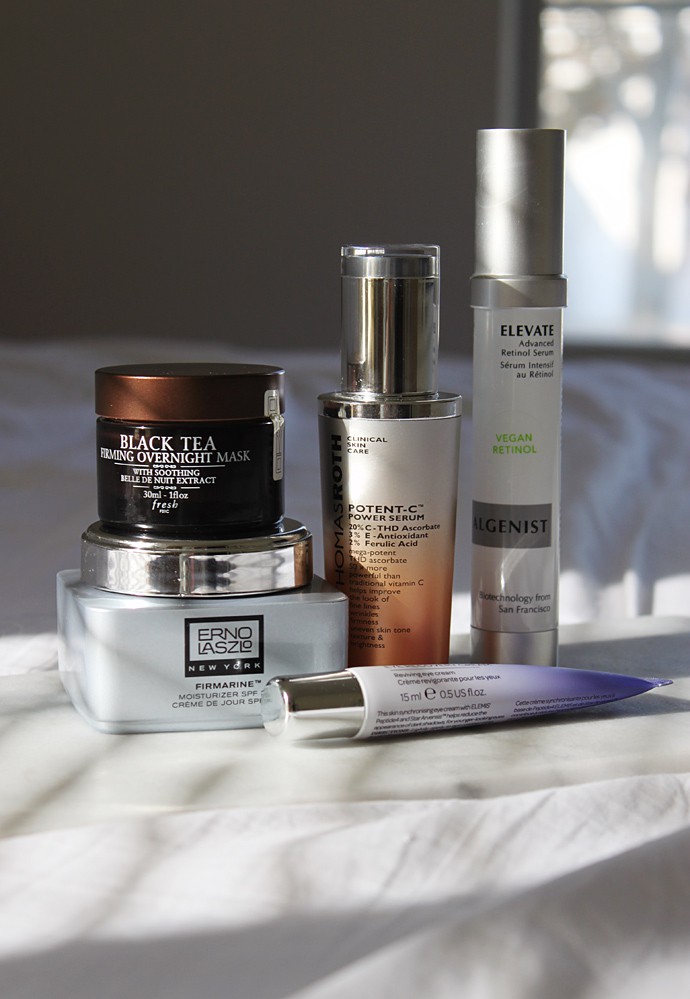My Anti-Aging Skincare Routine That Works (backed by science)
I know I wrote a similar post before, probably multiple times too, but it’s definitely time to update you on my latest skincare routine. I am now 34 years old, and some of my favorite products that used to work in the past seem to no longer have any effect. I changed a few things since the last post, and now I focus more on making sure that my lineup includes specific actives in specific concentrations vs your typical product-type step-based routine. Keep on reading, I promise it will make sense!
AM MUST HAVES:
- Vitamins C, E, and F (10%+, pH3.0-4.0)
- Peptides
- SPF
Most of the skin aging is actually caused by the UV rays, so I think it’s important to max out on sun protection and antioxidants during the day. For my AM routine I chose Vitamins C, E and F and a broad-spectrum SPF as my absolute must-haves.
When Vitamin C is used in concentrations of 10% and higher with pH3.0-4.0, it works as both a potent antioxidant and a skin-brightening ingredient to address PIH [post-acne skin discoloration]. Combination of Vitamins C and E is clinically proven to offer superior photoprotection when used together vs if you used just Vitamin C or just Vitamin E on their own in the same dosage [science]; but adding Ferulic Acid to the mix doubles the effect!! [science]
As for peptides, in the past I used them purely because I always thought they work well for me. There is finally some credible research proving their effectiveness [science], and the results look promising!
Here’s what I actually use right now, in the order of application:
- Peter Thomas Roth Potent-C™ Power Serum ($95) – This is one of my most favorite serums ever, and definitely a #1 favorite among PTR offerings. This serum combines 20% THD Ascorbate [which is a non-irritating, stable form of Vitamin C], 3% Vitamin E, and 2% Ferulic Acid, so it’s an antioxidant champion and a kickass brightening product. It’s fragrance-free as well. It’s expensive, but I do think this one might actually be worth a splurge. It just makes such a big difference in my skin’s overall appearance that I can see myself justifying that purchase in the future. To compare, I like it more than Skinceuticals CEF serum and Drunk Elephant’s C-Firma, which are both considered to be cult favorites among skincare aficionados.
- Elemis Peptide 4 Eye Recovery Cream ($45) – This eye cream works well for my AM routine because it’s light but not too light, just enough to keep my skin moisturized throughout the day without any shine or greasy residue. It sits well under makeup, doesn’t pill, and contains a peptide complex that my skin responds well to.
Honestly, with SPF it all comes down to preference. It doesn’t really matter to me if it’s chemical, physical, or a mix of both as long as I enjoy the texture. There are so many great sunscreens on the market that I am not loyal to any particular one.
Right now I am using the following:
- Erno Laszlo Firmarine Moisturizer SPF 30 ($100) – This is currently my go-to moisturizer with SPF. It has a rich creamy texture that feels very nourishing, but surprisingly not too heavy. The formula includes peptides, Vitamins A, C, E, mineral-rich seawater, spirulina extract, jojoba oil, and three chemical sunscreen agents for broad spectrum protection – Avobenzone 3%, Octisalate 5%, and Octinoxate 7.5%. Although I like it, I don’t plan to purchase another jar, because it’s kind of expensive yet the results I see from this cream are a lot more subtle than the PTR serum I mentioned above [which is worth every penny IMO].
PM MUST HAVES:
- Niacinamide (5%)
- Retinoids
- Peptides
The research proving the anti-aging effectiveness of retinol is so extensive that I don’t think it needs any further proof. I use my retinoids at night, because some of them are notoriously unstable in the presence of sunlight. It’s also the perfect time to use richer products that would otherwise be too heavy to wear during the day [as long as they don’t clog the pores of course].
Niacinamide is one of my favorite skincare ingredients, and in 5% concentration specifically it’s been clinically proven to improve the appearance of fine lines and wrinkles. It also works wonders for brightening and strengthening the skin barrier [science].
Here are my current PM actives, in the order of application:
- Elemis Peptide 4 Eye Recovery Cream ($45) – I use this eye cream both AM and PM because why not? Sometimes I mix in a drop of marula oil when I want it to be extra nourishing but it works perfectly well as is.
- Algenist ELEVATE Advanced Retinol Serum ($98) – This is one of the brand’s latest launches, and being a fan of their other products I had high hopes for this serum. The formula features slow release vegan retinol encapsulated with green algae, so it basically works all night until I wash it off in the morning. Slow release formulas rarely irritate my skin, and I didn’t have a bad reaction from using this serum either. Other noteworthy ingredients include Vitamin E, squalane, and ceramides to soothe the skin and prevent the dryness commonly associated with retinoids. The serum also contains an array of peptides high up on the list. Despite being kind of pricey, I think it might be a worthy splurge. The serum works well to improve skin texture and the formula is a lot less irritating than most other retinoids I tried to date.
- Natural Pacific Phyto Niacin Whitening Essence ($17.75) – This serum is an absolute pleasure to use – it’s super gentle even for sensitive skin, has a fragrance-free formula with no added colors, and doesn’t sting or feel uncomfortable in any way at all. It contains 5% Niacinamide as well as Sodium Hyaluronate which is perfect to layer over retinoids. It makes a great pair with my Algenist serum, and ‘completes’ it in a way, because Niacinamide & HA provide relief and boost the skin’s barrier which can be affected by using retinol. P.S.: This serum now comes in new packaging, but the product is the same.
I managed to stave off wrinkles pretty well so right now I use milder, non-prescription retinoids. But if I had more pronounced lines, I would probably look into something stronger, like tretinoin.
OTHER PRODUCTS:
- Cleansers (foaming, balm, cream, oil, micellar water)
- Moisturizers (toners, lotions, oils, eye creams)
Cleansing is important, and in a way it helps fight against skin aging. I normally follow a 2-step cleansing method by dissolving my makeup with an oil or a balm first, then follow up with a mild foaming cleanser to remove everything from the skin.
I’m going to sound like a broken record here, but I always test my foaming cleansers for pH. A good foaming cleanser should serve only one function – gently remove surface dirt, oil, and debris without disturbing the skin’s protective acid mantle. I just ignore the marketing spiel and use whatever sounds fun as long as the product meets the most important criteria: pH around 5.0-5.5. In rare cases I go up to 6, but never higher than that. Ever.
Clinical research supports that notion [science, and more science], so I am surprised that beauty companies still release highly alkaline cleansers on the market. Some people believe that if the skin doesn’t feel squeaky then it’s not really clean, but again, we have science on our side here as well [science]. There is absolutely no benefit to using an alkaline cleanser unless you work at a coal mine or with sticky substances like motor oil. I strongly suggest buying these pH strips and testing everything that touches your face if you are serious about anti-aging.
I own a wide variety of low pH cleansers and use them all interchangeably because I tend to get bored. These are currently sitting in my bathroom:
- Son & Park Beauty Water ($30) – To think that all of my skincare used to be all k-beauty, and now there are only two k-beauty products left in my routine! I guess this low pH micellar water counts as a cleanser, because I use it in the morning to wipe my face instead of washing it. I recently wrote a whole blog post about using micellar water as a morning cleanser, and tested about six of them. Check it out here!
- DHC Deep Cleansing Oil ($28) – This gentle cleansing oil is a cult classic along with Shu Uemura oils. I massage it into dry skin – including the eye area – to dissolve makeup, and then rinse it off with lukewarm water. It does a good job on its own, but I like to follow up with a foaming cleanser to ensure my skin is totally makeup-free.
- NOW® Solutions Charcoal Detox Gel Cleanser ($9.99) – I reviewed this cleanser in more detail in this blog post, but basically it’s a fantastic skin-friendly low pH second cleanser that makes my face feel super soft and clean, never dried out. If I ever make a Fall Favorites post, it will definitely be there!
In the morning my SPF doubles as a moisturizer, but in the evening I usually add an extra product, like a rich cream, a sleeping pack, or sometimes an oil. I used to use oils a lot more often but lately I only reach for them when I test them. Don’t get me wrong, I’m not saying that oils are useless. In fact, I think they’re pretty fabulous! I even featured a couple of my recent tryouts on IG, if you want to check those out. But as far as actives go, my routine is pretty much complete so an oil wouldn’t add any value to it right now, except maybe bring on an extra occlusive layer or more antioxidants when I feel like I could use a little oomph.
Here are the remaining products I actually use daily:
- Fresh Black Tea Firming Overnight Mask ($92) – The texture is absolutely heavenly, it’s kind of like a thick, stretchy paste, if that makes sense. It kind of envelops my face like a cocoon and I can almost feel it ‘seal’ in the rest of my skincare underneath. The mask is super moisturizing and my skin always looks plumper in the morning. The formula features a ton of various antioxidants, as well as peptides and HA.
- Herbivore Botanicals Jasmine Green Tea Balancing Toner ($39) – I won’t lie, I mostly use this because it smells heavenly. I like to mist my face with this toner right after cleansing just to give myself some time to apply other skincare products. You need a layer of hydration on the skin for humectants to be effective, so I try to always use a hydrating toner or apply skincare immediately after cleansing while there’s still some water left on the surface. By the way, this bottle is a re-purchase. I recently finished my PR sample and bought this one as a replacement with my own money.
BOTTOM LINE:
Well, now you know what my current routine looks like! I tried to explain why I use these products, but if my explanation was unclear and you want to learn more, feel free to drop a comment below. I’d like to think that I have my routine all figured out, but honestly it’s just a never-ending quest for more knowledge and learning to decipher my skin’s needs.
Keep in mind, topical skincare products will never be as effective as professional treatments. There is a lot of misinformation out there, and some brands really like to push the envelope with their marketing wording. No serum can replace Botox or be as effective as injections, and an IPL facial will yield much better results than any brightening cream. Still, skincare is a great way to rejuvenate your skin if professional treatments are not in the budget. For me, even if I wanted to get something done, it would be difficult and inconvenient. I live in a small rural town, and getting a high quality aesthetic procedure would require traveling 100 miles one way. To be honest, I would rather spend that time doing something else instead. 😉
Stay tuned for the Part II where I will tell you about the masks and peels I use weekly!








